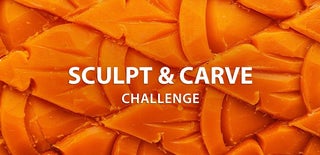Introduction: How to Make a Figurine Using Clay (Ninja Turtle)
In this tutorial, I made the ninja turtle Donatello. My father's birthday was coming up and he loves the ninja turtles, so I thought it would be a great idea to make him his favourite turtle. I will walk you through how I make my sculptures.
Supplies
Materials needed are:
Clay - I used Super Sculpey original clay for this project because it has a slow drying time and allows me to work on one section at a time. Depending on the size of the figurine, you can use Super Sculpey Ultralight (or tin foil) as a base to mold the clay around. It makes a lighter end product and uses less clay.
Liquid clay/Bake and bond - Liquid clay is used mainly as a glue. If you need to attach non-baked clay to something else, you can put some liquid clay on one of the surfaces, attach together, then bake to harden the bond. It hardens just like normal clay but because it is liquid it can fill gaps. You can also use it to attach baked clay to baked clay.
Armature wire - This is what give figurine structure to make sure it won't sag or flop over. It's like a skeleton, and the more clay/weight that is put on, the stronger/thicker the wire should be.
Tape/Thin wire - This is used to attach multiple pieces of armature wire to create the figurine structure.
Cutting mat - I used more than one mat for this project. I used a cutting mat that is essential to have, and I used a painting mat. A painting mat is optional, but I used it so I wouldn't get paint on my good cutting mat.
Plaque - You might want to have a plaque to put your figurine sculpture on once it's done. Unless it can stand on it's own, you will want some sort of base to keep it on. It could be wood, or foam, really anything.
Clay pasta maker - This is optional but I use it to make sheets of clay with a consistent thickness. If you don't have/want one you can use a rolling pin or your hand.
Pliers - Pliers are used for bending the armature wire to the shape you choose. You can do it with your hand but depending on the thickness of the wire, you will want pliers for sharp bends and such.
Paper and pencil/pen - This you will need if you want a sketch of the sculpture to base your armature wire on. You might want a ruler and eraser.
Lamp/light source - I used this because it can help with seeing details and eliminate shadows.
Sculpting tools - You can use any tools you feel comfortable with. I use silicone clay shapers, ball stylus tools, some metal tools like a spoon tool, and some wood tools.
Knife/blade - You will want some type of blade because ripping off pieces of clay won't do the trick. A knife will cut the clay easily without affecting the rest of the sculpture.
An oven - This will bake the clay and harden it to preserve it, and keep it from getting squished and wrecked.
Step 1: Sketching/pictures
To start the amazing process of making a figurine, you need to start with a sketch or a reference picture.
If you choose to sketch the character, you will want to sketch him/her/them very relaxed, with none of their body bending (their limbs straight) so you get the correct measurement. It doesn't have to be too detailed, you can have muscle definition, lines for where the bending points are, etc. (Example of mine above).
If you choose to print out a picture, make sure to find one with clear measurements and no foreshortening.
Step 2: Armature
The next thing you want to do is line up your armature wire to the sketch to get the precise measurements. I used two pieces of wire, one for the legs and torso, and one for the arms. You can attach the two wires by wrapping the two pieces that connect using a really skinny wire or tape. I used tape because when I tried a small wire it moved.
Once the two pieces were connected, I used Super Sculpey Ultralight to form the inside of the figurine. Now bake the clay to harden the structure.
Tip: If it's a really big sculpture, I use tin foil first, and then use Ultralight clay. I use Ultralight because it's easier to work with than tinfoil, it's smoother, it's easier to shape, and makes the skeleton strong. You don't want to use Ultralight for the entire figurine sculpture as it is too soft which doesn't allow sufficient definition and detail.
Step 3: Pose
Find reference images of different poses so you can choose the perfect one. Once you have chosen the right pose, you can start bending the wire to shape the pose.
Tip: If arms or legs are bent, you may want to bend those parts later so you can work bit by bit with the clay. You can always change a part of the pose if it doesn't feel right.
The picture above was my inspiration.
Step 4: Anatomy and Body
Once you have the wire posed, you can start adding Super Sculpey original clay to the skeleton. I started building a leg by shaping the clay into a general form, then added muscle definition using my shaping tools. You can add muscle by adding clay bits or carving it away. Having the reference images will be a huge help when adding detail. Using a blade at this step is one of the most useful tools. You can cut small slivers of clay off the figurine to get fine detail. If you are happy with the sculpted body section and detail (ie. leg) and are ready to move on, bake the clay in the oven per the package directions or at 270 Fahrenheit for 10-15 minutes. Repeat steps above to sculpt each body section (i.e. torso, arms, etc) and bake per above as each section is completed.
Step 5: Clothing and Accessories
To start clothing, you have to have an idea of what you want. If you have a clay pasta maker, you can use it to make thin even sheets, perfect for clothing. When you add the sheets of clay, you can use your blade to adjust it a little bit and cut extra clay off. Make sure to add wrinkles on the clothes to make it look more realistic. In this step, I added a pizza in the turtle's hand, straps that would be used for the bo staff along the chest and back, and elbow guards, knee guards, and wristbands. You can make whatever you want for the accessories.
Step 6: Head
I started shaping a sphere for the head. I then marked the sphere with small lines to indicate where the facial features would go. I dug small holes where the eyes would go, then added tiny balls of clay for the eyes. Thin rolled out clay can then be used to build up the face, and be used as eye lids over the eyeballs. I shaped tiny pieces of clay to make the eye brows, nose, lips and cheek bones. Work with the clay to shape the main neck muscles which blend towards the back of the jaw and the base of the skull.
Tip: Using your own face as reference can be very helpful for visualizing different positions and facial expressions to help make your figurine more realistic.
If you are finished shaping and detailing the head, you can attach the head to the figurine body using Liquid Sculpey. You are now ready to bake! If you are completely finished with sculpting, bake your Super Sculpey original clay figurine at 270 Fahrenheit for up to 30 minutes.
Step 7: Detail on the Landscape
I wanted a detailed landscape for my ninja turtle's feet. First I shaped a piece of stone for each foot to help my figurine stand by itself. Then I made bricks from a rectangle piece of clay. I used my knife to cut the clay into brick shapes. I cooked them and then used my knife again to carve details and break some of them for a realistic look. When my stone and bricks had the detail I wanted, I baked them at 270 Fahrenheit for 10 minutes.
Step 8: Optional: Painting
I painted the ninja turtle sculpted figurine to ensure my colours matched my reference image. I painted a base colour for each section (i.e. green for body, brown for shell). Then added details by layering colours and using a variety of brush sizes.
Painting is optional because if you are using coloured clay, you might not need to paint unless you want a lot more detail. There are plenty of painting tutorials and videos on Youtube that can teach you different techniques.
Step 9: Finished Product!
I then took my painted figurine and mounted it to a wood plaque using Gorilla super glue. I then glued each brick to the plaque to create the landscape I wanted.
And there you go! Now you can go and make your own sculpted clay figurine. Have fun with it! If it's your first model, try out different techniques and see what works for you.

Runner Up in the
Sculpt & Carve Challenge











